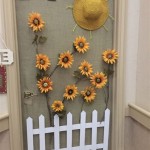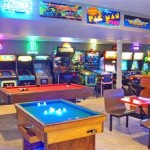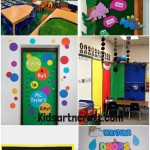How To Decorate Kids Bedroom Walls: A Comprehensive Guide
Decorating a child's bedroom walls presents a unique opportunity to create a space that is both functional and inspiring. The walls serve as a blank canvas upon which to express the child's personality, interests, and developmental stage. Effective wall decoration can foster creativity, promote learning, and contribute to a comforting and stimulating environment conducive to rest and play. This article provides a comprehensive guide to decorating kids' bedroom walls, outlining various strategies, considerations, and techniques to achieve a visually appealing and age-appropriate space.
The selection of wall decorations should align with the child's age, preferences, and the overall theme of the room. It is crucial to consider the durability and safety of the materials used, opting for non-toxic paints and secure mounting methods. Parental involvement in the decorating process can transform the task into a collaborative and enjoyable experience, fostering a sense of ownership and pride in the child's personal space. By carefully planning and executing the wall decoration strategy, one can transform a simple room into a personalized haven that promotes a child's well-being and development.
Choosing the Right Paint and Color Scheme
Paint serves as the foundational element in any wall decoration project. The selection of paint type and color scheme significantly impacts the mood and atmosphere of the room. When choosing paint, prioritize low-VOC (Volatile Organic Compounds) or zero-VOC options to minimize indoor air pollution and potential health risks. These paints release fewer harmful chemicals into the air, ensuring a safer environment for the child.
The finish of the paint is another crucial consideration. Matte finishes offer a soft, non-reflective appearance but are less durable and harder to clean. Eggshell or satin finishes provide a good balance between aesthetics and durability, offering a slight sheen that is easier to wipe down. Semi-gloss or gloss finishes are the most durable and easiest to clean, making them suitable for high-traffic areas or walls that are frequently touched. However, these finishes can be highly reflective and may highlight imperfections in the wall surface. For children's rooms, an eggshell or satin finish is generally recommended.
Color selection is paramount in establishing the desired ambiance. Light and neutral colors, such as pastel shades, whites, and creams, can create a sense of spaciousness and tranquility. These colors are versatile and easily complemented by other decorative elements. Brighter colors, such as blues, greens, yellows, and oranges, can stimulate energy and creativity. However, it is essential to use brighter colors judiciously, as excessive use can lead to overstimulation and restlessness. Consider using brighter colors as accent walls or in smaller decorative elements to add pops of vibrancy without overwhelming the space.
The color scheme should also take into account the room's natural lighting. Rooms with ample natural light can accommodate darker or more saturated colors, while rooms with limited natural light benefit from lighter colors to maximize brightness. Testing paint samples on the walls before committing to a particular color is crucial to ensure it looks as expected under the room's specific lighting conditions.
Furthermore, consider incorporating themed color palettes that align with the child's interests. For example, a nature-themed room might feature earthy tones of green, brown, and blue, while a space-themed room could incorporate shades of blue, purple, and silver. Color psychology principles can also be applied to create a desired mood. Blue is often associated with calmness and serenity, while yellow evokes feelings of happiness and optimism. Understanding these associations can help in selecting a color scheme that promotes the child's well-being.
Exploring Wall Decor Options: Beyond Paint
While paint provides the foundation, a variety of wall decor options can add depth, texture, and personality to the room. These options range from simple and affordable to more elaborate and customized solutions.
Wall decals are a versatile and easily removable option for adding visual interest. These self-adhesive stickers come in a wide array of designs, including animals, characters, geometric patterns, and educational elements. Wall decals are easy to apply and remove without damaging the paint, making them ideal for temporary decoration or for children who frequently change their preferences. Choose decals made from non-toxic materials and ensure they are securely adhered to the wall to prevent choking hazards.
Wallpaper offers a more permanent and impactful wall covering solution. Available in a vast range of colors, patterns, and textures, wallpaper can transform the entire look of a room. While installation can be more complex than applying decals, many modern wallpapers are designed for easy application and removal. Consider peel-and-stick wallpaper options for a less permanent solution. When selecting wallpaper, opt for durable and washable materials, particularly in high-traffic areas. Choose patterns that complement the overall theme of the room and avoid overly busy designs that can feel overwhelming.
Wall murals can create a stunning focal point and immerse the child in a specific theme or environment. Murals can be professionally painted or created using large-scale wallpaper panels. Custom murals offer the opportunity to personalize the artwork to the child's specific interests and preferences. When considering a mural, ensure the design is age-appropriate and avoids potentially frightening or disturbing imagery. Choose colors and imagery that promote calmness and creativity.
Framed artwork and photographs can add a personal touch to the walls. Displaying the child's artwork, family photos, or prints of their favorite characters can create a sense of belonging and pride. Choose frames that complement the overall decor and ensure they are securely mounted to the wall. Consider using shatterproof glass or acrylic to prevent injuries. Creating a gallery wall with a collection of framed pieces of varying sizes and styles can add visual interest and personality.
Shelving provides both decorative and functional storage. Floating shelves can be used to display books, toys, and decorative objects. Shelves can also be used to create a display area for the child's collections or hobbies. Ensure shelves are securely mounted to the wall and are within the child's reach. Choosing shelves with rounded edges and avoiding sharp corners can minimize the risk of injury.
Fabric wall hangings can add texture and warmth to the room. Tapestries, quilts, or decorative panels can be hung on the walls to create a cozy and inviting atmosphere. Choose fabrics that are easy to clean and maintain. Ensure the fabric is securely mounted to the wall to prevent it from falling and potentially causing injury.
Incorporating Educational and Interactive Elements
Kids' bedroom walls offer a valuable opportunity to incorporate educational and interactive elements that promote learning and development. These elements can transform the walls into a stimulating and engaging environment that encourages exploration and discovery.
A chalkboard wall or chalkboard paint can provide a dedicated space for drawing, writing, and creative expression. This interactive element allows children to freely express their imagination and practice their fine motor skills. Chalkboard paint can be applied to an entire wall or a designated area. Ensure the surface is properly prepared before applying chalkboard paint. Providing a variety of chalk colors and erasers can enhance the experience.
A whiteboard wall or whiteboard paint offers a similar interactive experience as a chalkboard wall, but with the added benefit of using erasable markers. Whiteboard paint can be applied to an entire wall or a designated area. Ensure the surface is properly prepared before applying whiteboard paint. Providing a variety of dry-erase markers and erasers can enhance the experience. Whiteboard walls are particularly useful for practicing math problems, writing assignments, or creating collaborative artwork.
A map of the world or a map of a specific region can provide an educational and visually stimulating wall decoration. Maps can be used to teach children about geography, cultures, and different landmarks. Choose a map that is age-appropriate and features clear labeling and vibrant colors. Encourage the child to explore the map and learn about different places.
Alphabet and number charts can help children learn basic literacy and numeracy skills. These charts can be displayed on the walls in a visually appealing manner. Choose charts that are age-appropriate and feature clear and legible fonts. Encourage the child to interact with the charts and practice their reading and counting skills.
Growth charts can track the child's height and provide a visual representation of their growth. These charts can be integrated into the wall decor in a creative and personalized manner. Choose a growth chart that is durable and easy to read. Mark the child's height at regular intervals and celebrate their progress.
Magnetic walls can be created by applying magnetic primer or using magnetic paint. This allows children to easily attach and rearrange magnets, creating interactive displays and artwork. Magnetic walls can be used to display alphabet magnets, number magnets, or magnets featuring the child's favorite characters. Ensure the magnets are age-appropriate and do not pose a choking hazard.
By incorporating these educational and interactive elements, the walls of a child's bedroom can become a valuable learning resource that promotes their cognitive and creative development. It is crucial to select elements that align with the child's age and interests, creating an environment that is both stimulating and engaging.

7 Kids Room Decorating Tips To Create A Fun Space

Kids Room Decorating Ideas For Your Home Designcafe

7 Kids Bedroom Decor Ideas That Won T Break The Bank Pamap

Creative 100 Kids Bedroom Wall Decor Ideas How To Transform Room With Realm Of Imagination

How To Decorate A Kids Room Create Calm And Intentional Place For Rest Ytical Mommy Llc

70 Stylish Kids Room Ideas That Even Grownups Will Love

50 Clever Kids Bedroom Storage Ideas You Won T Want To Miss

Vintage Inspired Kids Rooms Decorating Ideas She Holds Dearly

Kid S Room Decorating Spaces That Grow With Them

Diy Name Art Ideas Kids Bedroom Wall Decor







